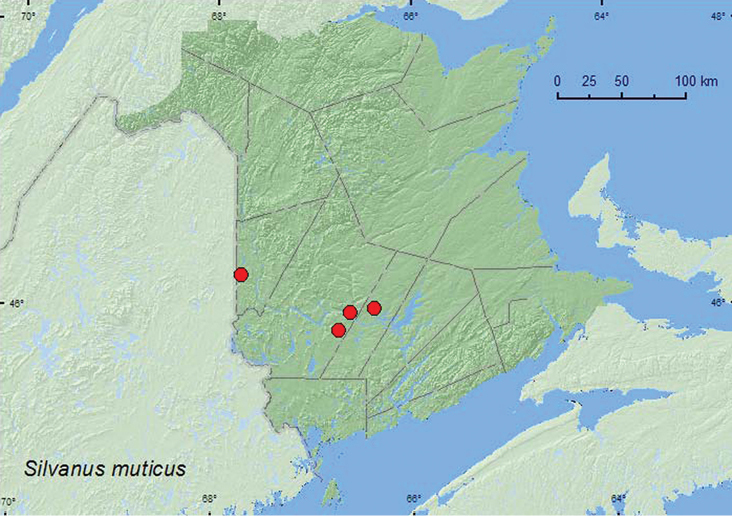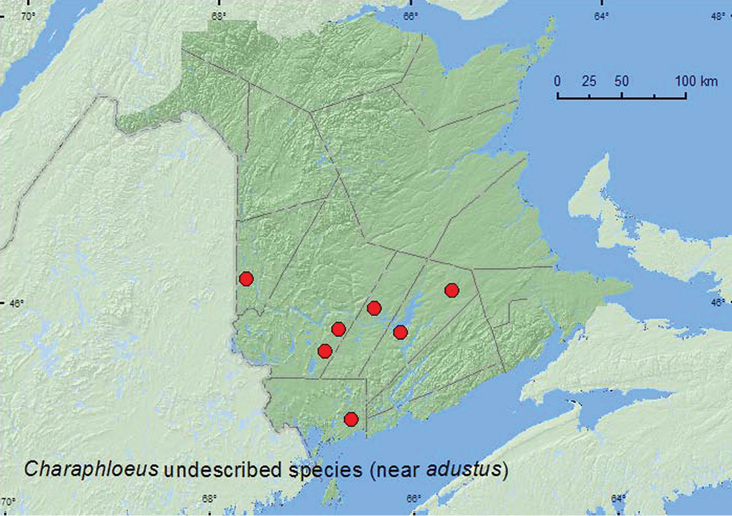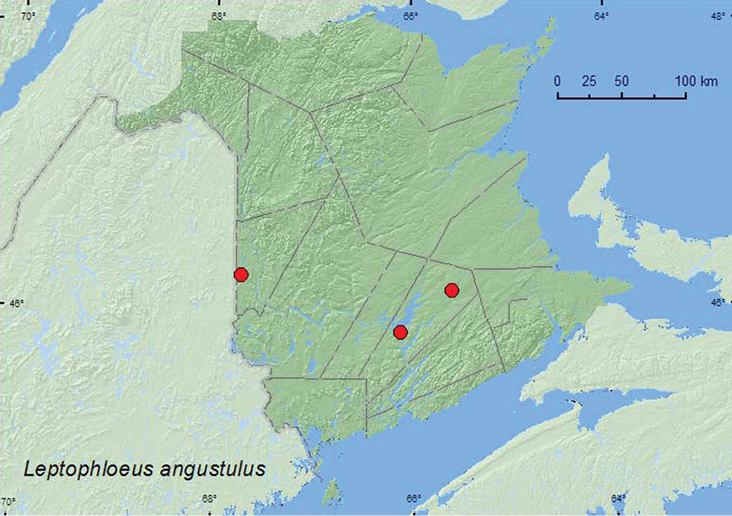






(C) 2012 Reginald P. Webster. This is an open access article distributed under the terms of the Creative Commons Attribution License 3.0 (CC-BY), which permits unrestricted use, distribution, and reproduction in any medium, provided the original author and source are credited.
For reference, use of the paginated PDF or printed version of this article is recommended.
One species of Silvanidae, Silvanus muticus Sharp, is newly recorded from New Brunswick, Canada and the Maritime provinces; Ahasverus longulus (Blatchley) is re-instated to the faunal list of the province, and we report the first recent provincial records of Dendrophagus cygnaei Mannerheim. Five species of Laemophloeidae (Charaphloeus convexulus (LeConte), Charaphloeus undescribed species (near adustus), Leptophloeus angustulus (LeConte), Placonotus zimmermanni (LeConte), and an undescribed Leptophloeus species) are added to the faunal list of New Brunswick. Collection data, bionomic data, and distribution maps are presented for all these species.
Silvanidae, Laemophloeidae, Leptophloeus, new records, Canada, New Brunswick
This paper treats new records from New Brunswick of two related families of beetles, the Silvanidae and the Laemophoeidae. The Silvanidae, Cucujidae, and Laemophloeidae of Atlantic Canada were reviewed by
The following records are based, in part, on specimens collected during a general survey by the first author to document the Coleoptera fauna of New Brunswick and from by-catch samples collected in Lindgren funnel traps during a study testing attractants for detection of longhorn beetle species. Additional records were obtained from specimens contained in the collection belonging to Natural Resources Canada, Canadian Forest Service - Atlantic Forestry Centre, Fredericton, New Brunswick.
Collection methodsVarious methods were employed to collect the species reported in this study. Details are outlined in
Distribution maps, created using ArcMap and ArcGIS, are presented for each species in New Brunswick. Every species is cited with current distribution in Canada and Alaska, using abbreviations for the state, provinces, and territories. New records for New Brunswick are indicated in bold under Distribution in Canada and Alaska. The following abbreviations are used in the text:
Acronyms of collections examined or where specimens reside referred to in this study are as follows:
AFC Atlantic Forestry Centre, Natural Resources Canada, Canadian Forest Service, Fredericton, New Brunswick, Canada
CNC Canadian National Collection of Insects, Arachnids and Nematodes, Agriculture and Agri-Food Canada, Ottawa, Ontario, Canada
NBM New Brunswick Museum, Saint John, New Brunswick, Canada
RWC Reginald P. Webster Collection, Charters Settlement, New Brunswick, Canada
| AK | Alaska | MB | Manitoba |
| YT | Yukon Territory | ON | Ontario |
| NT | Northwest Territories | QC | Quebec |
| NU | Nunavut | NB | New Brunswick |
| BC | British Columbia | PE | Prince Edward Island |
| AB | Alberta | NS | Nova Scotia |
| SK | Saskatchewan | NF & LB | Newfoundland and Labrador |
All records below are species newly recorded for New Brunswick, Canada, unless noted otherwise (additional records). Species followed by ** are newly recorded from the Maritime provinces (New Brunswick, Nova Scotia, Prince Edward Island) of Canada.
The classification of the Silvanidae and Laemophloeidae follows
Species of Silvanidae and Laemophloeidae recorded from New Brunswick, Canada.
| Family Silvanidae Kirby |
| Subfamily Brontinae Blanchard |
| Tribe Brontini Blanchard |
| Dendrophagus cygnaei Mannerheim |
| Subfamily Silvaninae Kirby |
| Ahasverus longulus (Blatchley)** |
| Nausibius clavicornis (Kugelann) |
| Oryzaephilus mercator (Fauvel) |
| Oryzaephilus surinamensis (Linnaeus) |
| Silvanus bidentatus (Fabricius) |
| Silvanus muticus Sharp** |
| Family Laemophloeidae Ganglbauer |
| Charaphloeus convexulus (LeConte)* |
| Charaphloeus undescribed species (near adustus)* |
| Cryptolestes pusillus (Schönherr) |
| Laemophloeus biguttatus (Say) |
| Laemophloeus fasciatus Melsheimer |
| Placonotus zimmermanni (LeConte)* |
| Leptophloeus angustulus (LeConte)* |
| Leptophloeus undescribed species ** |
Tribe Brontini Blanchard, 1845
Additional New Brunswick records. Carleton Co., Richmond, near Hovey Hill P.N.A. (Protected Natural Area), 46.1155°N, 67.7631°W, 10.V.2005, R. P. Webster, clear-cut (hardwood forest), under bark of Populus sp. (2, RWC); Jackson Falls, Bell Forest, 46.2200°N, 67.7231°W, 19–27.VI.2008, 5–12.VII.2008, R. P. Webster, mature hardwood forest, Lindgren funnel traps (3, AFC, RWC); same locality and habitat data but 23–28.IV.2009, 14–20.V.2009, R. Webster & M.-A. Giguère, Lindgren funnel traps (5, AFC). Charlotte Co., 10 km NW of New River Beach, 45.2110°N, 66.6170°W, 30.IV-17.V.2010, R. Webster & C. MacKay, old growth eastern white cedar forest, Lindgren funnel trap (1, AFC). Queens Co., Cranberry Lake P.N.A, 46.1125°N, 65.6075°W, 24.IV-5.V.2009, 21–27.V.2009, R. Webster & M.-A. Giguère, old red oak forest, Lindgren funnel traps (6, AFC). Restigouche Co., Dionne Brook P.N.A., 47.9030°N, 68.3503°W, 30.V–15.VI.2011, M. Roy & V. Webster, old-growth northern hardwood forest, Lindgren funnel traps (2, AFC, NBM); same locality and collectors but 47.9064°N, 68.3441°W, 31.V–15.VI.2011, old-growth white spruce and balsam fir forest, Lindgren funnel traps (3, AFC, NBM). Sunbury Co., Acadia Research Forest, 45.9866°N, 66.3841°W, 8–13.V.2009, 13–19.V.2009, 19–25.V.2009, R. Webster & M.-A. Giguère, mature (110-year-old) red spruce forest with scattered red maple and balsam fir, Lindgren funnel traps (4, AFC). York Co., Charters Settlement, 45.8342°N, 66.7452°W, 23.IV.2004, R. P. Webster, mixed forest, under bark of sugar maple (1, RWC); Charters Settlement, 45.8395°N, 66.7391°W, 19.V.2007, R. P. Webster, mixed forest, under bark of large Populus sp log (2, RWC); Canterbury, 45.8920°N, 67.6592°W, 8.VI.2004, D. Sabine & R. Webster, hardwood forest, under bark (1, RWC); 15 km W of Tracy off Rt. 645, 45.6848°N, 66.8821°W, 22–25.IV.2009, 25.IV-4.V.2009, 7–14.VII.2009, R. Webster & M.-A. Giguère, old red pine forest, Lindgren funnel traps (8, AFC, RWC); 14 km WSW of Tracy, S of Rt. 645, 45.6741°N, 66.8661°W, 26.IV-10.V.2010, R. Webster & C. MacKay, old mixed forest with red and white spruce, red and white pine, balsam fir, eastern white cedar, red maple, and Populus sp., Lindgren funnel traps (2, AFC).
Dendrophagus cygnaei was found in various forest types in New Brunswick, including hardwood forests, an old red oak (Quercus rubra L.) forest, mixed forests, a red spruce (Picea rubens Sarg.) forest, an old (180-year-old) red pine (Pinus resinosa Ait.) forest, an old-growth northern hardwood forest, an old-growth white spruce (Picea glauca (Moench) Voss) and balsam fir (Abies balsamea (L.) Mill.) forest, and an old-growth eastern white cedar (Thuja occidentalis L.) forest. Adults were collected from under bark of Populus and sugar maple (Acer saccharum Marsh.). This species was commonly collected in Lindgren funnel traps at most sites where these traps were deployed. Adults were collected during April, May, June, and July.
AK, BC, AB, MB, ON, QC, NB, NS (
Collection localities in New Brunswick, Canada of Dendrophagus cygnaei.
New Brunswick, Carleton Co., Jackson Falls, Bell Forest, 46.2200°N, 67.7231°W, 12.VII.2006, 25.VII.2007, R. P. Webster, mature hardwood forest, u.v. light (7, NBM, RWC). Sunbury Co., Acadia Research Forest, 45.9866°N, 66.3841°W, 2–8.VI.2009, R. Webster & M.-A. Giguère, mature (110-year-old) red spruce forest with scattered red maple and balsam fir, Lindgren funnel trap (1, AFC). York Co., Fredericton, at Saint John River, 45.9588°N, 66.6254°W, 7.VI.2005, R. P. Webster, river margin in flood debris (1, RWC); Charters Settlement, 45.8340°N, 66.7450°W, 16.VIII.2006, R. P. Webster, mixed forest, beating (dead) birch branches with dead dried leaves (4, RWC).
Silvanus muticus was collected in a mature hardwood forest, a mature (110-year-old) red spruce forest, and a mixed forest. Adults were collected by beating dead white birch (Betula papyrifera Marsh.) branches that had dead, dried leaves, sifting flood debris on a river margin, and at an ultraviolet light. Adults were collected during June, July, and August.
New Brunswick, York Co., Charters Settlement, 45.8428°N, 66.7279°W, 23.VI.2004, R. P. Webster & H. Goulet, small sedge marsh in moist grass litter (1, RWC); Charters Settlement, 45.8267°N, 66.7343°W, 14.V.2005, R. P. Webster, margin of Carex marsh/fen, in sphagnum and leaf litter at base of tree (1, RWC); 9.0 km W of Tracy off Rt. 645, 45.6889°N, 66.8002°W, 5.IV.2010, R. P. Webster, old beaver flowage, in grass litter on clay soil near small stream (1, RWC).
Ahasverus longulus was found in Carex marshes and in an old beaver (Castor canadensis Kuhl) flowage. Adults were sifted from grass litter and sphagnum and leaf litter at the base of a tree during May and June.
ON, QC, NB (
Collection localities in New Brunswick, Canada of Ahasverus longulus.
New Brunswick, Carleton Co., Jackson Falls, Bell Forest, 46.2200°N, 67.7231°W, 23–28.IV.2009, 28.IV–9.V.2009, 9–14.V.2009, R. Webster & M.-A. Giguère, mature hardwood forest, Lindgren funnel traps (8, AFC, RWC). Queens Co., Cranberry Lake P.N.A, 46.1125°N, 65.6075°W, 24.IV-5.V.2009, 5–12.V.2009, 21–27.V.2009, R. Webster & M.-A. Giguère, old red oak forest, Lindgren funnel traps (10, AFC, NBM, RWC). Sunbury Co., Acadia Research Forest, 45.9866°N, 66.3841°W, 25.V–2.VI.2009, R. Webster & M.-A. Giguère, mature (110 year-old) red spruce forest with scattered red maple and balsam fir, Lindgren funnel trap (1, RWC). York Co., Charters Settlement, 45.8395°N, 66.7391°W, 6.V.2008, R. P. Webster, mixed forest, in flight during warm (20°C) evening (1, RWC); same locality data and collector but 23–27.V.2009, mixed forest, Lindgren funnel trap (1, RWC); 15 km W of Tracy off Rt. 645, 45.6848°N, 66.8821°W, 25.IV–4.V.2009, R. Webster & M.-A. Giguère, old red pine forest, Lindgren funnel trap (1, AFC);14 km WSW of Tracy, S of Rt. 645, 45.6741°N, 66.8661°W, 25.V–2.VI.2010, R. Webster & C. MacKay, old mixed forest with red and white spruce, red and white pine, balsam fir, eastern white cedar, red maple, and Populus sp., Lindgren funnel trap (1, AFC).
Charaphloeus convexulus was found in various forest types in New Brunswick, including mature hardwood forests, an old red oak forest, mixed forests, a red spruce forest, and an old-growth red pine forest. However, this species was most frequently collected in hardwood forests. Most adults were captured in Lindgren funnel traps. One individual was captured with an aerial net during a warm evening. Adults were collected during April, May, and June (most during May). This species usually occurs under bark (
New Brunswick, Carleton Co., Meduxnekeag Valley Nature Preserve, 46.1890°N, 67.6766°W, 8.VI.2008, R. P. Webster & M.-A. Giguère, floodplain forest, on flowers of Prunus virginiana (2, RWC). Charlotte Co., 10 km NW of New River Beach, 45.2110°N, 66.6170°W, 17–31.V.2010, R. Webster & C. MacKay, old growth eastern white cedar forest, Lindgren funnel trap (1, RWC). Queens Co., Grand Lake Meadows P.N.A., 45.8227°N, 66.1209°W, 10–31.V.2010, 31.V-15.VI..2010, R. Webster & C. MacKay, old silver maple forest with green ash and seasonally flooded marsh, Lindgren funnel traps (2, RWC); Cranberry Lake P.N.A, 46.1125°N, 65.6075°W, 13–25.V.2011, M. Roy & V. Webster, old red oak forest, Lindgren funnel trap (1, RWC). Sunbury Co., Acadia Research Forest, 45.9866°N, 66.3841°W, 24–30.VI.2009, R. Webster & M.-A. Giguère, mature (110 year-old) red spruce forest with scattered red maple and balsam fir, Lindgren funnel trap (1, RWC). York Co., 15 km W of Tracy off Rt. 645, 45.6848°N, 66.8821°W, 4–11.V.2009, R. Webster & M.-A. Giguère, old red pine forest, Lindgren funnel trap (1, RWC); Charters Settlement, 45.8395°N, 66.7391°W, 2.V.2010, R. P. Webster, mixed forest, in flight during warm (20°C) evening, 16:30–20:00 h (1, RWC).
Most adults were captured in Lindgren funnel traps in a silver maple (Acer saccharinum L.) forest, an old-growth eastern white cedar forest, a red spruce forest, an old red pine forest, and a mixed forest. A few adults were collected from flowers of Prunus virginiana L. in a floodplain forest, and one was collected with an aerial net during an evening flight. Adults were collected during May and June.
NB, NS (
Collection localities in New Brunswick, Canada of Charaphloeus undescribed species (near adustus).
New Brunswick, Carleton Co., Jackson Falls, Bell Forest, 46.2200°N, 67.7231°W, 14–20.V.2009, R. Webster & M.-A. Giguère, mature hardwood forest, Lindgren funnel trap (1, RWC). Queens Co., Grand Lake Meadows P.N.A., 45.8227°N, 66.1209°W, 27.VI–5.VII.2011, M. Roy & V. Webster, old silver maple forest and seasonally flooded marsh, Lindgren funnel traps (2, RWC).
The New Brunswick specimens of Placonotus zimmermanni were captured in Lindgren funnel traps deployed in a mature hardwood forest with American beech (Fagus grandifolia Ehrh.) and sugar maple and in an old silver maple swamp. Adults at the latter site were captured in traps in the forest canopy.
New Brunswick, Carleton Co., Jackson Falls, Bell Forest, 46.2200°N, 67.7231°W, 19–28.VII.2008, R. P. Webster, mature hardwood forest, Lindgren funnel trap (1, AFC). Queens Co., Grand Lake Meadows P.N.A., 45.8227°N, 66.1209°W, 12–26.VII.2010, R. Webster & C. MacKay, old silver maple forest with green ash and seasonally flooded marsh, Lindgren funnel trap (1, RWC); Cranberry Lake P.N.A, 46.1125°N, 65.6075°W, 7–13.VII.2011, 13–20.VII.2011, 20.VII-4.VIII.2011, 4–18.VIII.2011, M. Roy & V. Webster, old red oak forest, Lindgren funnel traps (5, NBM, RWC).
This species was captured in Lindgren funnel traps deployed in a silver maple forest, a sugar maple and American beech forest, and an old red oak forest. Two of the specimens were captured in traps in the forest canopy. Adults in New Brunswick were captured during July. This species is apparently a predator of Scolytinae and has been collected from oaks infested with Pseudopityopththorus pruinosus (Eichoff) in Oklahoma (
NS, NB (
Collection localities in New Brunswick, Canada of Leptophloeus angustulus.
Map 8
New Brunswick, Restigouche Co., Dionne Brook P.N.A., 47.9064°N, 68.3441°W, 31.V-15.VI.2011, M. Roy & V. Webster, old-growth white spruce and balsam fir forest, Lindgren funnel traps (2, RWC).
Both adults were captured during June in Lindgren funnel traps deployed in an old-growth white spruce and balsam fir forest.
BC, AB, YT, QC, NB (
Collection localities in New Brunswick, Canada of Leptophloeus undescribed species.
We thank Caroline Simpson (AFC) for editing this manuscript, an anonimous reviewer for reviewing the manuscript, and Yves Bousquet (Agriculture and Agri-Food Canada (CNC), Ottawa) for determining specimens and other assistance. We thank Nichole Brawn, Kate Bredin, Katie Burgess, Marie-Andrée Giguère, Jim Edsall, Nancy Harn, Cory Hughes, Rob Johns, Marsell Laity, Colin MacKay, Wayne MacKay, Jessica Price, Michelle Roy, D. Sabine, and Vincent Webster for technical assistance and collecting specimens. Natural Resources Canada - Canadian Forest Service, the Canadian Food Inspection Agency, and the USDA APHIS are thanked for funding the study on early detection of invasive cerambycids, which provided many specimens collected in Lindgren funnel traps. We thank the New Brunswick Environmental Trust Fund and New Brunswick Wildlife Trust Fund for funding various insect surveys over the past 7 years, and the Meduxnekeag River Association for permission to sample beetles at the Meduxnekeag Valley Nature Preserve (which includes the Bell Forest). The New Brunswick Department of Natural Resources (Fish and Wildlife Branch) is thanked for issuing permits for sampling in the Protected Natural Areas and for providing logistical support.







